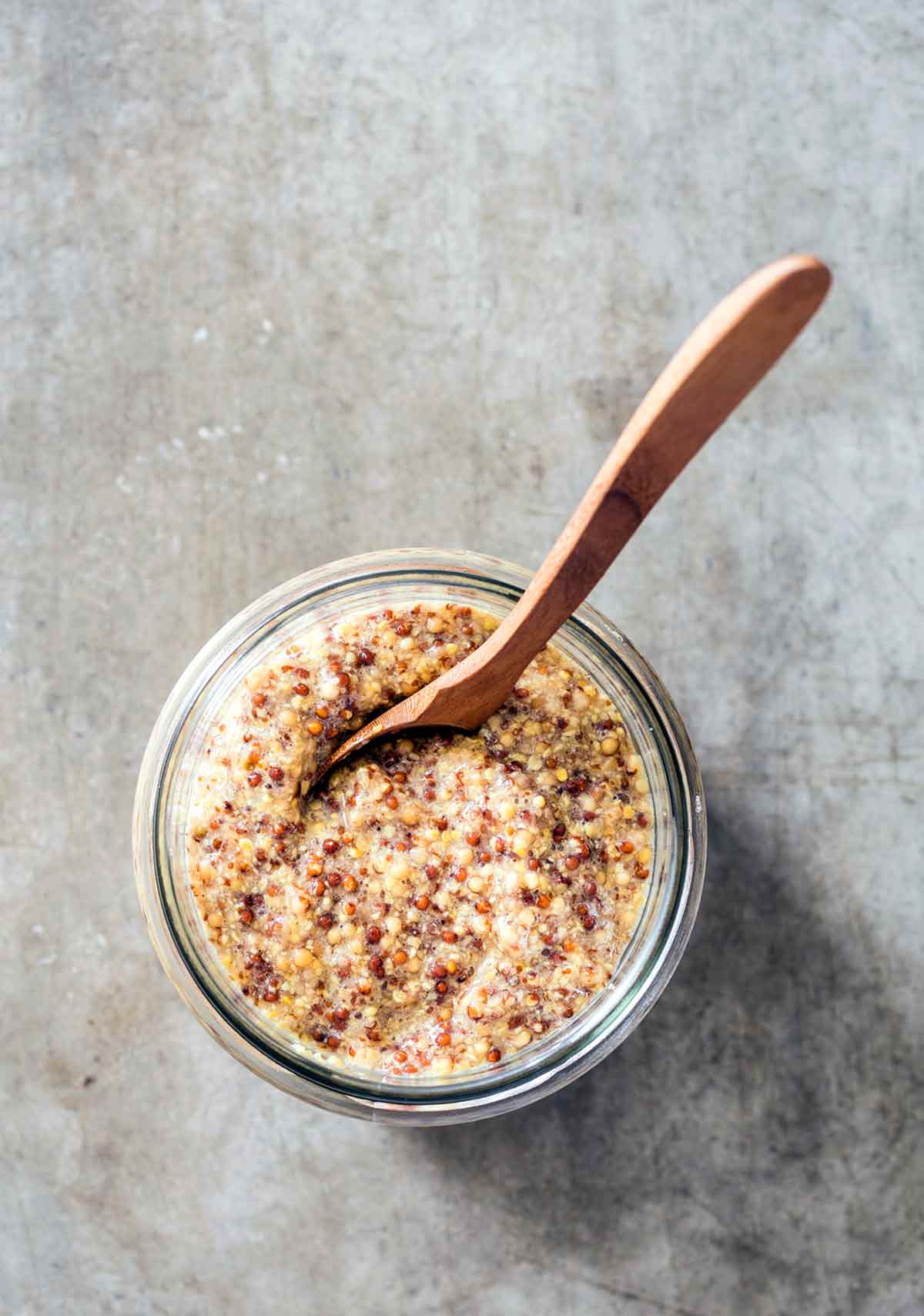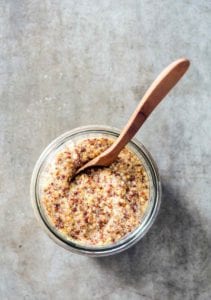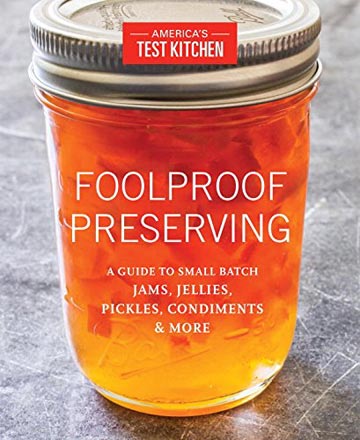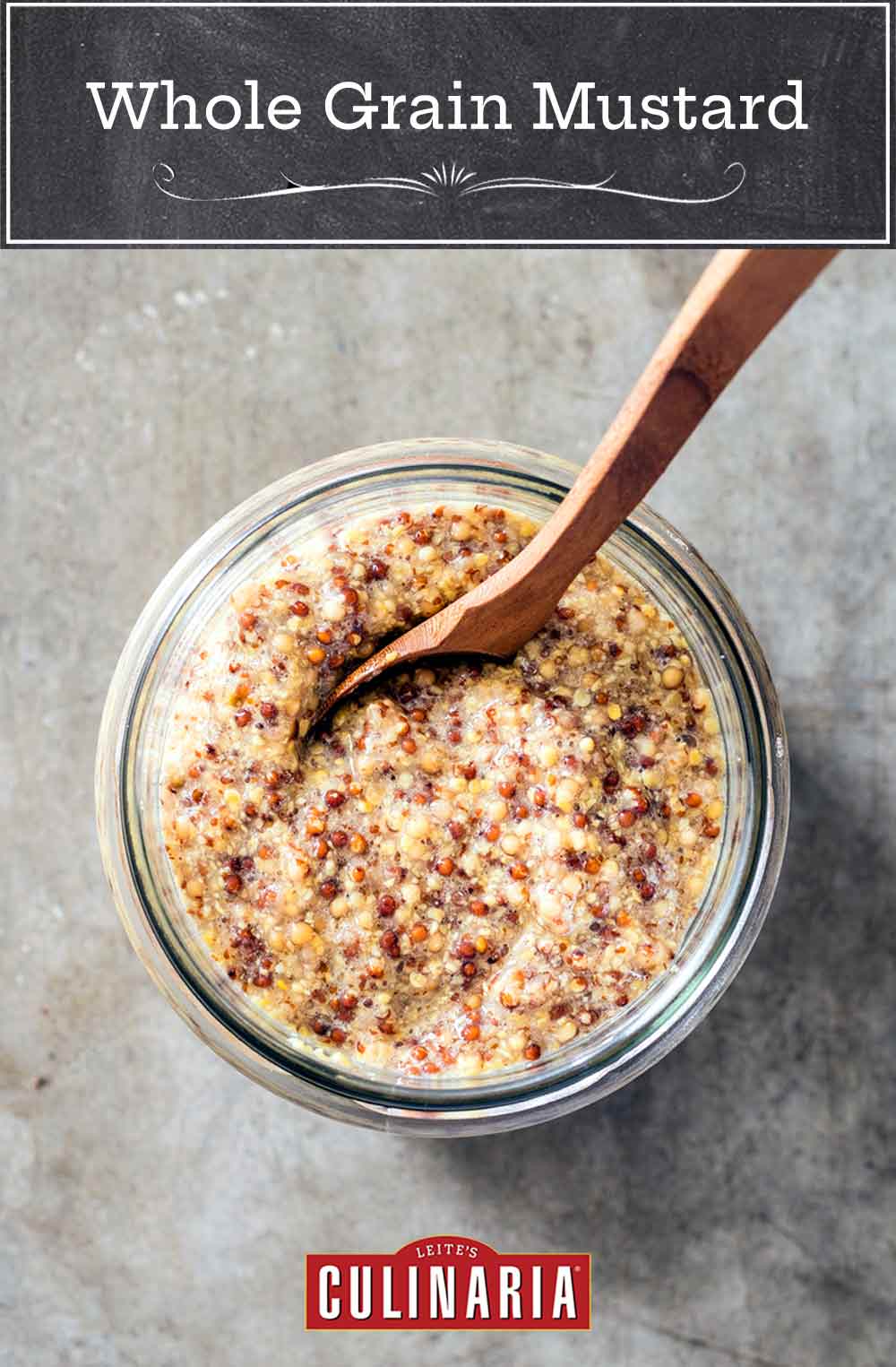
This homemade whole grain mustard, also known as grainy mustard, is simple and inexpensive to make, contains no preservatives, requires few ingredients, has ample uses, and, most importantly, is customizable to exactly the ratio of sharp to sweet that you want. You may never go back to store-bought mustard. Eat it. Gift it. Revel in it.
Why Do I Need Two Types of Mustard Seeds to Make This Whole-Grain Mustard?
Wondering why this homemade whole grain mustard recipe makes you buy two different types of mustard seeds? Yellow mustard seeds are relatively mild, whereas brown mustard seeds bring a more pungent, spicier bite. Together, they create some harmonious mustard magnificence.
Want to Save This?

How to Make Homemade Whole-Grain Mustard
Equipment
- Two half-pint jars and lids
Ingredients
- 3/4 cup cider vinegar
- 1/2 cup cold water
- 1/3 cup yellow mustard seeds
- 1/3 cup brown mustard seeds
- 1 to 2 tablespoons packed light brown sugar
- 1 1/4 teaspoons salt
Instructions
- In a medium bowl, combine the vinegar, water, yellow mustard seeds, and brown mustard seeds. Cover with plastic wrap and let stand at room temperature for at least 8 hours or up to 24 hours. (The resting time softens the seeds and ensures a creamy consistency.)
- Take your vinegar and mustard seeds mixture and measure out 1/2 cup (118 ml) and keep separate.
- In a small food processor or with an immersion blender, process the remaining vinegar and mustard seed mixture, sugar, and salt until coarsely ground and thickened, 1 to 2 minutes, scraping down the bowl as needed.
- Stir in the reserved vinegar and mustard seed mixture. Using a funnel and spoon, portion mustard into two 1 cup (237 ml) jars. Cover and let the mustard stand at room temperature for 1 to 2 days to allow the ingredients to meld and develop a well-rounded spiciness. The longer it rests, the spicier it gets.
- Taste it often and, once the desired spiciness has been reached, refrigerate and serve. (The mustard can be refrigerated for up to 6 months; once refrigerated, the flavor will continue to mature but will not become spicier.)

Explore More with AI
Nutrition
Nutrition information is automatically calculated, so should only be used as an approximation.
Recipe Testers’ Reviews
This homemade whole-grain mustard is my new favorite mustard! Very fast to make and the flavor is so much better than typical store-bought mustard. At first taste, it’s slightly sweet, but then it finishes with an awesome mustardy kick. I won’t be buying whole-grain mustard anymore.
Mustard is one of the most versatile ingredients in my pantry. I must admit that I never thought of making it myself, but this homemade whole grain mustard recipe is so easy, I could not resist. It made just about 2 cups which I put into small Mason jars and delivered to my grateful neighbors, who gave it rave reviews.
I soaked my seeds for 13 hours and let the mustard rest at room temperature for 3 days, stirring and tasting it every day. Besides using it as a garnish on sandwiches and of course hot dogs, it is a great addition to a pan sauce for fried pork chops, marinades, and vinaigrettes. It takes less than 5 minutes to combine the ingredients.
Variations on this recipe could include additions such as honey, different vinegars, and herbs. Many years ago, I was in Paris and had dinner in a tiny bar and order steak frites. The plate came out with a spoonful of grainy mustard and crème fraiche. It is a common practice to mix the two and dip your steak into it. It was delicious and I now always serve it with my steaks. Try it!
This homemade whole-grain mustard is such a fun yet simple thing to make. It’s easy to tweak the texture, sweetness, and heat exactly to your taste. I also love any recipe that can double as a food gift!
I let the vinegar, water, and mustard seed mixture stand for 16 hours. I did not find the food processor method to be super effective in grinding down the mustard seeds to smooth and thicken the mixture. I had it going for about 2 minutes and the mixture still looked rather thin. I moved the mixture to a bowl and used my immersion blender, pulsing it for about 30 to 60 seconds, to excellent effect. After aging it 1 day, we liked the level of heat—we are fans of spicy food. It was sweeter than I expected, which isn’t a bad thing, but I think you could cut the amount of brown sugar down to 1 to 1 1/2 tablespoons brown sugar and it would be more similar to a classic whole-grain mustard.
My life has changed now that I know how simple it is to make my own mustard. Seriously. I have no excuse to not do this all the time. Just 10 to 15 minutes of hands-on time was all it took to put together this delicious whole grain mustard. This mustard is seriously delicious! I really don’t think I’ll go back to store-bought. It is so satisfying to make your own condiments, especially when they taste so much better than a lot of what you can get in the store.
I let the seeds initially soak for 2 days, because that’s when I was able to get to it before work. I think this step can be a very loose time-frame. I processed the mixture for about 2 minutes. At that point, the mixture was smooth and well combined but the seeds weren’t totally broken down. I prefer a chunkier mustard, so next time I might process for a bit less time. However, my mixture is pretty thin, I don’t know if blending more would help or taking some of the vinegar out of the mixture before the final steps. Once combined, the mixture sat at room temp for 2 days, at that point it had nice spice but the sweetness from the brown sugar and roundness of apple cider really balanced everything out. My yield was exactly 2 cups.
This mustard is the perfect combination of sweet and spicy. Holding back some of the seeds and processing the rest gives the mustard a really nice consistency. This really put me in mind of my college days, when I worked part-time at Hickory Farms. They had a great mustard to eat with cheese. When I tasted my finished mustard, I immediately wanted to put together a cheese board so I could sit and dip cheese into mustard all evening. For very little effort, you can have a great homemade condiment!
Well, this mustard is not for sissies! The longer it sits, the better it is. At first taste, the mustard is very sharp and pretty awful. I tasted it every 12 hours for 2 days and the flavored mellowed remarkably. I refrigerated 1 jar after 24 hours and the second jar after 36 hours. The 24-hour jar isn’t too much spicier than the 36-hour, but just enough to give it an extra kick. And the flavor really does mature as it sits. I will definitely make this mustard again given how easy it is. It takes 5 minutes to throw together and a minute to blend. Why buy it? And I can’t see any reason why this basic recipe can’t be tweaked. Would stirring in thyme leaves or swapping the sugar for honey be an issue?
I made mustard from scratch a few years ago using a different recipe. This homemade whole-grain mustard far exceeded my expectations and I fully expected to never buy mustard from the store again. However, the recipe I used was time-consuming and, as good as my intentions were, I never got around to making a second batch. The beauty of this particular whole-grain mustard recipe is you don’t need a lot of time to get it started. Most of the time it takes to create this mustard is hands off, which makes it very doable for me.
I also love the fact that there are instructions on how to make it milder or spicier depending on my needs. Since it makes a pretty good-sized batch, in the future, I might split it into 1 cup mild and 1 cup spicy. I will definitely be using this recipe again. My food processor did not do a great job of processing this smallish amount of ingredients so I used my stick blender in a mason jar, which produced the coarsely ground and thickened mustard in 2 minutes.
This homemade whole-grain mustard is spectacular and very easy to make. It took just a few minutes to prepare. I soaked the mustard seeds overnight and after processing I let mine sit for 24 hours. This mustard is super spicy. If you like hot mustard, you will love this one. My only tip is to go to your local Indian grocery for mustard seeds. You will get a large quantity for much less money.














Mustard tasted great, but it was super liquidy. I thought it might thicken up when I blended it, but nope, still liquid. Blending further did not help either. I’m gonna try to see if I can strain some of the solids, cause I would rather not dump it
Hi Benjamin,
I’m glad the flavor hit the mark, even if the texture is giving you trouble!
The runny issue usually happens for one of two reasons: either the seeds didn’t fully absorb the liquid during the soaking stage (sometimes this happens with older, drier seeds), or the mixture just hasn’t had time to set yet. Homemade mustard is rich in natural thickeners (mucilage) that are released during blending, but they often take 24 to 48 hours to fully activate and firm up the sauce.
Before you try straining it (which can be messy and might lose some of that great grainy texture), try these two steps:
The Waiting Game: If you haven’t already, let it sit in the jar for another day or two. It often thickens significantly on its own as the chemical reaction settles.
The Quick Fix: If it’s still too thin for your liking, whisk in a teaspoon or two of dry mustard powder (like Colman’s). This will soak up the excess liquid and thicken it instantly without altering the flavor profile.
Let me know if that does the trick!
Hello. Can you plz advise if I can use apple vinegar or white wine vinegar instead of cider vinegar? If yes, will the amount used be the same? Thank you.
Isma, apple vinegar is the same as apple cider vinegar. Does that help?